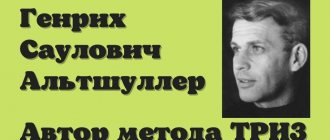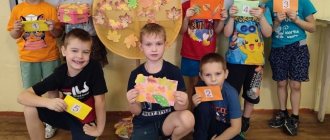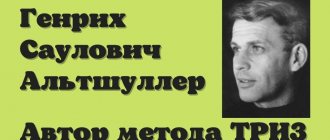“Application of TRIZ methods in the everyday life of preschool educational institutions.”
MASTER CLASS
"APPLICATION OF TRIZ METHODS
IN THE DAILY LIFE OF KINDERGARTEN"
Target:
—
increasing the professional competence of teachers participating in the master class in the field of application of TRIZ technology in the educational process of kindergarten in the course of active pedagogical communication.
Master class objectives:
· expand the knowledge of preschool teachers about the variety of gaming techniques of TRIZ technology and their practical application in the everyday life of kindergarten;
· encourage the use of TRIZ games - technologies in joint activities with children .
· To create motivation among master class participants to use methods and techniques of TRIZ technology in their teaching activities .
Material and equipment:
multimedia installation, computer, presentation, route sheets for the implementation of technological maps, technological maps, models of thinking, visual material for games, game guide “Carousel of Features”.
Progress of the event:
1.Relevance.
The process of raising and educating a child is a glimpse of modern humanity into the future. The main task of the education system is to prepare the younger generation for a creative life in tomorrow. We have entered a rapidly changing world, the era of the information revolution. Knowledge that is relevant today will become hopelessly outdated tomorrow. And this naturally led to the emergence of a number of global problems in the field of education at all levels. There is an obvious new need to teach children to live in a dynamic, rapidly developing world.
Traditionally, in pedagogy the question is brought to the fore: WHAT TO TEACH? Education often relies on the transmission of outdated knowledge. And how can one keep up with science if technological and scientific paradigms began to change within one generation?
It is obvious that the content of education today should be considered, first of all, in children’s mastery of technologies for working with new knowledge, the development of their research skills, and the ability to independently obtain information that is missing for solving problems.
Accordingly, the question arises: how to build the educational process today? What can really be changed in the education system of children, starting from preschool age? Some answers to this question are given by the pedagogical direction, today called TRIZ - pedagogy.
TRIZ - pedagogy is defined as a pedagogical direction that reveals the essence, goals, objectives of the process of education and training, based on the general laws of the theory of solving inventive problems.
TRIZ pedagogy is based on:
1. Methods and technologies that allow you to master ways to remove psychological inertia (development of creative imagination - RTV);
2. Methodology for solving problems, based on the laws of development of systems, general principles of resolving contradictions and mechanisms for applying them to solving specific creative problems (general theory of strong thinking - OTSM);
3. An educational system built on the theory of development of a creative personality (theory of development of a creative personality - TRTL).
The effectiveness of TRIZ pedagogy lies in its instrumentality, relative universality and sufficient guarantee of the formation of students’ research skills. Working with models allows you to use OTSM – TRIZ – RTV approaches to implement any educational program.
2. Description of the work on introducing TRIZ technology into the educational process of the second junior group.
I began work on introducing TRIZ technology into the educational process of my 2nd junior group by studying theoretical and methodological literature, manuals, and watching video seminars of leading experts.
At the moment there are 3 Main Russian TRIZ schools.
“Classical” TRIZ pedagogy (Leningrad TRIZ school)
Main representatives: A.V. Kislov, E.L. Pchelkina M.N. Shusterman
Peculiarities:
The “classical” school programs are closest to the “adult” TRIZ. Children gradually become familiar with the following concepts: fantasy techniques, function, system, system operator, ideal end result, conflicting couple, resources, physical and technical contradiction, patterns of development of technical systems, etc. Children learn to solve problems using an algorithm using the example of social and everyday situations.
OTMS (General Theory of Strong Thinking)-TRIZ (Ulyanovsk TRIZ school)
Main representatives:
N.N.
Khomenko, I.Ya. Gutkovich, I.N. Muraszkowska, A.A. Nesterenko, T.A. Sidorchuk and others. Features:
OTSM is a broader area because it considers tools for solving problems not only in technical systems, but also in social, organizational and others. If we talk about OTSM in pedagogy, then here we see a lot of experience in integrating elements from RTV and TRIZ into other educational subjects. This, first of all, is important for the formation of an objective picture of the world in children. OTSM-TRIZ has many methodological platforms based on kindergartens and schools; in their programs they take into account the requirements of the Federal State Educational Standard, conduct intramural and correspondence competitions of research projects, and organize visiting conferences.
“Popular” TRIZ pedagogy (Moscow TRIZ school)
Main representatives:
A.A.
Gin, I.Yu. Andrzheevskaya, S.A. Gin, A.F. Kavtrev and others. Features:
“Popular” TRIZ is aimed at both teachers and parents, providing overview knowledge about the education and development of creativity. Clearly explains and popularizes the need to develop creative thinking and imagination. The main concept concepts are open problems (there are materials on fairy tales and various school subjects) and creative battles (team competitions to solve such problems).
Analysis of the literature, comparison of the possibilities of using TRIZ methods in different age groups of preschool educational institutions, ranking TRIZ methods in accordance with the stages of introducing TRIZ technology into the educational process led me
to the methodological complex “I know the world” created on the basis of OTSM-TRIZ-RTV
by a certified specialist of the International TRIZ association, scientific director of the public organization "Volga - TRIZ", candidate of pedagogical sciences
Sidorchuk Tatyana Aleksandrovna
The methodological complex "I know the world" was developed as a solution to the problem of planning work with OTSM - TRIZ - RTV technologies in preschool institutions and is aimed at developing the intellectual - creative and cognitive activities.
The main pedagogical tool
implementation of MK: modeling of mental actions. For a child, these are diagrams of the steps of an algorithm that allows you to solve some cognitive problem.
The teacher should not learn algorithm diagrams with children. It is necessary to create pedagogical conditions under which preschoolers become aware of
steps of the algorithm with their subsequent schematization in front of the children. This scheme is a signal sign that allows the child to apply a well-known algorithm to organize his own intellectual and creative activity.
The methodological complex includes:
— technological maps for the implementation of OTSM - TRIZ - RTV methods.
A total of 67 technological maps in six areas:
— analyzers (6 cards),
— signs of objects (17 cards),
- questions (7 cards),
— cause-and-effect relationship (1 card),
— transformers (12 cards), thinking models (24 cards);
-route sheets for the implementation of technological maps in different age groups;
-checklists for monitoring;
- a universal visual aid for children “I am exploring the world” (six zones combined into a single storyline).
Using the OTSM - TRIZ - RTV methodology in my work,
I developed:
· Planning for the development of TRIZ technology by children of the younger group, based on route sheets for children 2-3 years old and 3-4 years old, developed by the authors of the international TRIZ association of the public organization "Volga-TRIZ" "led by scientific supervisor T.A. Sidorchuk, since they contain the basic competencies that need to be developed in children while working with this technology.
· Technological maps for familiarization with the capabilities of the sensory organs and the emotional state of a person
· Technological maps for familiarization with the names of features.
· Technological maps for children’s development of ways to formulate questions.
· Technological maps for children’s development of methods for transforming the characteristics of objects. (Typical fantasy techniques)
· A catalog of games and trainings to develop systems thinking for preschool children.
· A card index of games for the development of creative imagination in preschool children.
· A draft universal manual has been compiled, which contains schematic images of 17 meanings of feature names, question marks, images of “smart head assistants”, human analyzer organs, figures of “wizards”, transformers of object features, a manual for developing the ability to establish cause-and-effect relationships.
Work on creating a methodological case continues. It is planned to produce a playbook “Explore the World”, circles of Lull, and enrich the “Magic Chest” with subject pictures.
I have been conducting practical work on technological maps in the form of game trainings in the form of experimental, research activities, using practical observations, inspections of objects based on information relevant to the child from the outside world since December.
Tatyana Aleksandrovna Sidorchuk draws attention to the role of analyzers in mastering the world around us: “A person learns the world through various means and methods, but the first steps of getting to know the world around us allow us to make the senses, our “smart head assistants.” Therefore, at the first stage of work, I began to introduce children to analyzers
(tactile, visual, auditory, olfactory, tactile).
In parallel with the analyzers, in
regulated and joint activities, I introduced children to “Magic Cards” with the names of signs that help describe objects
(humidity, temperature, size, shape, smell, taste, sound, color, place, direction, quantity, action, relief, material , parts, weight, time). A sign is any characteristic of an object, this is the side by which it can be recognized, defined or described, which serves as a sign, a sign of the object.
Familiarization with the signs took place in a certain order:
Stage 1: A sign comes to visit the children, and at the request of the teacher, the pupils begin to look for the meaning of this sign in their immediate environment;
Stage 2: Children’s ideas about the concepts “name of feature, meaning” are clarified
feature name";
Stage 3: Appearance of a schematic representation of the feature name. Accommodation
schemes for the name of a feature in the game manual “Poznavaykin’s World”;
Stage 4: Children independently determine the meaning of the name of a feature in the world around them.
For example: “Magic card - color” - asks the object what color it is? “Shape card” - what shape is it? All these questions come from the card itself
I become familiar with the names of signs during game trainings.
To conduct game trainings, it is necessary to prepare cards depicting the names of the characteristics.
Practical part
Game training “Carousel of signs” with teachers.
Goal: consolidation of feature names .
Progress: The manual is a circle made of fabric or oilcloth, on which there are 17 circles for sign icons along the edge and 1 circle for an object in the center.
Conducted with a subgroup of children. The teacher invites 3-4 children to stand in a circle, choose an object and begins to count: 1,2,3-run. (children run in a circle around the playground.)
Educator:: 1,2,3- freeze.
(Children stop)
.
sign icon card , provided that they are familiar with 17 signs (as many icons are laid out as they know)
.
One by one, the children name the attribute and characterize the selected object by it. For example: Teacher: Olya, Petya, Masha go out. Olya, choose an object. (Olya Selects grapes and puts them in the center.)
1,2,3 - run.
1,2,3-freeze. (Olya says: I have a sign of temperature . Which grapes are based on temperature ? - warm. Petya says: I have a sign of humidity. What are the grapes based on humidity ? - dry on the outside, juicy on the inside. Masha says: I have a sign of quantity . How many grapes? - there is one brush, but there are many berries.)
Pedagogical science has determined that creative thinking already in preschool age begins to be systemic in nature and among the factors that have the greatest influence on its formation are the level of development of creative imagination and the formation of intellectual operations (analysis, synthesis, comparison, establishment cause-and-effect relationships, etc.).
Therefore, in play activities with children in the group, games are actively used to develop the ability to identify the functions of an object, determine the lines of development of an object, identify supra-system and sub-system connections, classify objects and compare systems.
“What can he do?”
, “What Was - What Became”, “Earlier-Later”, “Locomotive” , “Where Does He Live?” , “Magic Traffic Light”, “Good-Bad”, “Masha-Confused”, “One, Two, Three, Run to Me!”, “What It Looks Like”, “Teremok”, “Everything in the World Is Confused”
Work is being organized on “Magic path” with one vertical indicator (hero) and two to four horizontal indicators (shape, color, size). The work is based on the visual perception of the “Magic Path”. Pictures (diagrams) of objects are used to indicate indicators. From 3.5 years of age, it is useful to place the “hero” on the border of different indicators (sign values).
Ex .: a bunny got on the border of the paths - he stands on both the green path and the red one. What color did he become?
Practical part. Game "Teremok" with teachers.
Rules of the game
Children are given various object pictures. One child (or a teacher in the younger group) plays the role of leader. Sits in the "teremka". Everyone who comes to the “teremok” will be able to get there only if they say how their object is similar to or different from the presenter’s object. The key words are: “Knock, knock.” Who lives in the little house?
Note:
During the game, the leader can change the settings: “I’ll let you into the tower if you tell me how you’re like me. Or: “I’ll let you into the little house if you tell me how you differ from me.”
Game “One, two, three, run to me!” with teachers.
Rules of the game:
The presenter distributes pictures depicting various objects to everyone playing. Depending on age, the content of the pictures changes: in younger groups these are objects of the immediate environment, animals. The children stand at the other end of the hall and, according to a certain instruction of the teacher, run up to him.
Progress of the game:
“One, two, three, everyone who has wings, run to me!” (Children run up with images of an airplane, a bird in the picture...) The rest of the children stand still. “One, two, three, those who can sing, run to me!”, “One, two, three, everyone who used to be little, run to me!”
3. Conclusion.
In conclusion, we can say that, despite the difficulties, working with basic models gives positive results in the formation of the cognitive abilities of young children. Under the guidance of a teacher, children successfully master ways of learning the meanings of signs through analyzers; generalize the meanings of feature names, assigning them a name, group objects by features, and recognize them by description. I noticed that children have become more sociable and are not afraid to express their opinions. The main thing is that children develop the ability to listen to each other and respect the opinions of other children. I consider working on the TRIZ system important, interesting and necessary.
TRIZ pedagogy has created a fairly extensive fund of trainings, techniques, and methods that make it possible to develop in a child the ability to see a systematic picture of the world, operate with contradictions, and, at an older age, purposefully overcome psychological inertia and solve problems of a creative nature from different fields of knowledge and human activity.
I tried to select games for you that you can play with the children of your groups. TRIZ gives you and your children methods and tools of creativity that a person can master regardless of his age. By owning a single instrument, children and adults can more easily find a common language and understand each other. When raising and teaching your child, be guided by the motto: “Creativity in everything!”
4.Reflection .
I thank you for participating in the master class and invite you to evaluate its productivity. Before you is the “Magic Tree”
-If you liked it, the information is interesting, there are a lot of impressions and the master class was fruitful , attach an apple.
-If something was missing, it was interesting, but burdensome, attach a flower.
-If you were not interested, indifferent, the information was useless, then attach the piece of paper.
Dear Colleagues! At the end of our meeting, I would like to wish you a flight of fantasy, the beauty of the images you create in your classes,
What if the child answers “I don’t know”?
In fact, those who work using the TRIZ method are faced with a variety of situations, including childish stubbornness, reluctance to make contact, and getting involved in games using the TRIZ method. And we have already prepared recommendations for you on what to do in these cases [K. Nesyutina, 2014]. As a rule, such situations happen due to shortcomings on the part of adults. If desired, such situations are completely correctable, and over time, you can ensure that, upon hearing a question, the child begins to think about the answer, and not just remain silent or say “I don’t know.”
What to do to get your child to start thinking and reasoning:
- Never scold children for giving the wrong answer! Very often, “playing the silent game” is a consequence of the fact that the child has already said or done something wrong, received a bunch of comments, and is now simply afraid of making a mistake again.
- Reason with your child and don’t act like an examiner or a know-it-all. Children are acutely aware of falsehood, and if the child is already accustomed to the fact that you always know the correct answer and ask questions only for the purpose of testing, he may not want to be a test subject. Especially if, in case of an incorrect answer, he will also be scolded.
- Ask so-called “open” questions, for which there cannot initially be one single correct answer. This will make it easier for you to reason with your child, and the child will not be afraid to make mistakes. At the same time, he will understand that a different opinion is not necessarily wrong.
- Answer the questions your children ask you. Otherwise, children will quickly learn that they don’t have to answer or answer all “Whys” with “Because it ends in “y.” As a rule, children pick up such excuses from adults.
We wish that your children are healthy and happy, and that you always find a common language with them! We remind you that our program “TRIZ in practice: a creative approach at work and in life” and a screening test on the topic of the article are waiting for you:
We also recommend reading:
- Storytelling
- TRIZ and design thinking in everyday life
- Secrets of inventors: a selection of useful materials
- Good books for self-education
- Charette procedure
- A selection of useful materials about creativity and creativity development
- TRIZ classes for children: raising geniuses and simply happy people!
- Invention: a selection of useful materials
- Creativity Development Digest
- TRIZ, RTV and TRTL in practice: dealing with the Soviet intellectual past
- TRIZ fairy tales in pedagogy
Key words:1TRIZ





